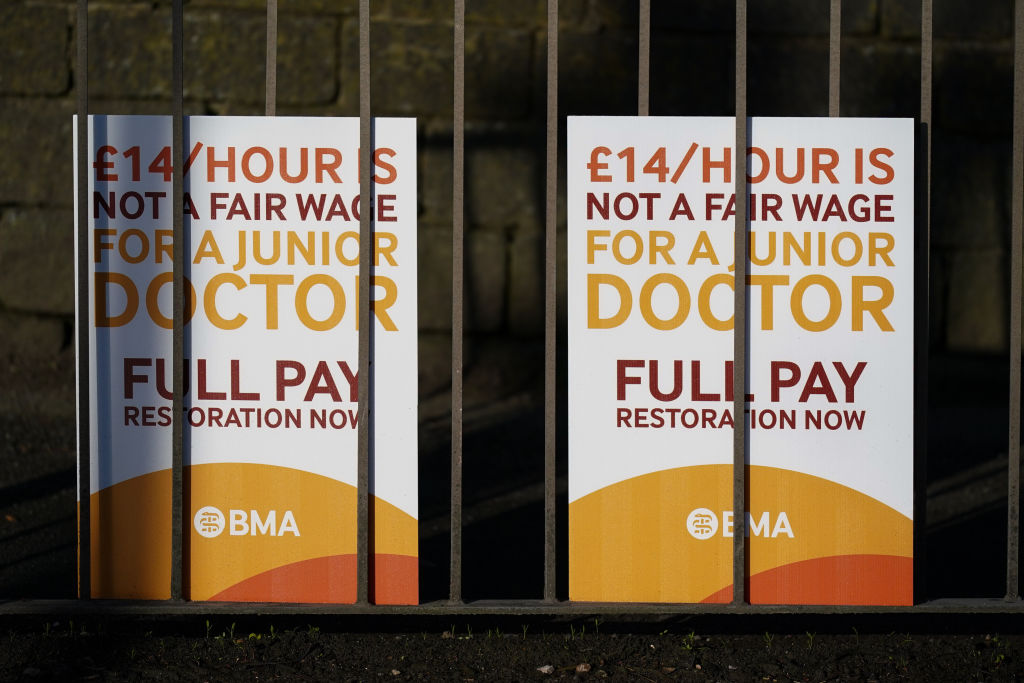As of this afternoon, the junior doctor strikes in Scotland have been called off. Today, the Scottish government and the BMA Scotland’s Junior Doctor Committee announced a brand new, three-pronged deal in a bid to end the pay dispute. Junior doctors in Scotland will receive a single pay rise of 12.4 per cent for this year, and over the following three years, the government has guaranteed a minimum pay rise in line with the rate of inflation for each financial year. Not only that, contract negotiations with the aim of improving both working conditions and training will begin this autumn, to be implemented by April 2026.
First Minister Humza Yousaf has been desperate to avoid healthcare workers striking since he was health secretary and it was a success he cited regularly during the leadership contest. Perhaps the approach of his 100 day milestone — today — pushed the First Minister to take bigger steps in the race to stop the strikes. It would certainly be one achievement, at least. For it is a record pay deal: the new offer means, coupled with the 4.5 per cent rise awarded in 2022/23, junior doctors in Scotland will receive a rise of 17.5 per cent over two years. And it’s a significant step forward from the previous offer of 6.5 per cent, which Yousaf only recently described as the ‘best pay deal ever’.
The deal is set to cost the Scottish government £61.3 million, and will result in pay uplifts of between £3,400 and £7,100 depending on how far medics are into their careers. But while the strikes have been called off temporarily now, will it be enough to draw a permanent line under the industrial action?
‘At this stage, our negotiating team feel they have reached the limit of what can be achieved this year and do not think strike action would result in a materially improved offer,’ Dr Chris Smith, chair of the Scottish Junior Doctor Committee, said after a union meeting today. Calling the new deal an ‘unprecedented shift’ from the Scottish government, Dr Smith commended the deal as being a ‘recognition of the huge decline in real terms pay’ experienced by medics since 2008. Meanwhile, health secretary Michael Matheson said he was ‘delighted’ to have reached a deal with BMA Scotland, saying that he hoped the offer ‘will show junior doctors how much we value them’.
But medics are conflicted. While a significant improvement on the last deal, it’s still not the 35 per cent full pay restoration (FPR) they’ve been campaigning for. Some believe that this offer may be the best outcome they’ll get, though even among this group there remains a scepticism about the ‘arbitrary nature’ of the inflationary rises over the next three years. There is also confusion about what exactly contract negotiations will involve. Others are adamant that, while the deal is a step in the right direction, FPR should remain the ultimate goal. The prevailing attitude is that there will be no loss to the medics if they reject the offer and ask for more — if they don’t get it, this pay deal is the fallback. And as long as Yousaf remains keen to prevent doctors striking, there is certainly a logic to putting the threat of industrial action back on the table to see how high the SNP government will go.
Even if more can be squeezed from the Scottish government, prolonged negotiations may see public support for the doctors nosedive. This pay deal is already more generous than that offered to teachers and nurses and if union members are beginning to soften to Yousaf’s latest offering, it’s likely many more of the public will view it as a reasonable compromise. Already, disagreements are springing up between BMA members about how much further the government should be pushed and with each subsequent offer — if there are to be more — the divide between the more ‘militant’ members and those willing to settle for less will widen. As one medic warned: ‘If the fight is too long, there will be no one left.’







Comments